
A Sensitive Survival Topic: hygiene
Any number of short to long-term disasters could leave you without power and/or running water. The result is a serious but difficult topic in prepping: hygiene. Without running water, using your toilet becomes problematic. And showering or bathing is no longer a daily routine that is taken for granted. Without power, you won’t have hot water from the water heater for washing pots, pans, dishes, glasses, or for washing hands.
The ideal solution is to have a home with its own well, its own septic system, and a solar and/or wind source of off-grid power. Then you will be all set. The next best solution is to move in with someone who has that type of home and resources. If these two solutions don’t work for you, read on.
Suppose that you no longer have a source of running water or power. What are your options?
Fortunately, the typical toilet plumbing does not require electricity. It works by the force of water and gravity. What you do need, to flush the toilet without running water, is plenty of water (a few gallons at least) for each flush. The water need not be drinkable (i.e. potable), but you need about 5 gallons per person per day for flushing (about 1 flush per person per day). Some more efficient toilets might flush with less water, but you are always better off with more water.
What this means is that, in addition to your stored drinking water and some water purification equipment, you also need a source of non-drinkable (non-potable) water. You might collect some rainwater, using the rain spouts on your house. Be advised that collecting rain water is actually illegal in some localities. There are some commercial products that capture water from rain gutters and store it in a large barrel (about 50 gallons). One of these on each side of the house is 100 gallons, but only about 20 flushes.
You could use water from a swimming pool. Or you might want to have a couple of very large water storage container, very large, kept outdoors for just such an eventuality. But the amount of water needed, say for a month or two without running water, gives you an idea of the scope of the problem.
If this type of situation continues long term, you are going to need another approach, but I’m not sure what will work. You could set up an outhouse, or any type of outdoor latrine. There are few other options. Running water is difficult to replace as a part of modern comfortable living. If you are without food, you can grow your own food. If you are without drinking water, you can purify the gallon or so of water you need each day. But without running water, long-term, your options are all not very good.
Bathing is another problem when you lack running water. The amount of water needed to shower or fill a bathtub to a shallow extent is at least 5 to 10 gallons. Washing with less water than that is undesirable. You also need water for washing your hands. You can use alcohol-based hand cleanser to a limited extent, to kill bacteria. Eventually, you need to actually wash off dirt and grime. So again the situation requires a substantial amount of water on a monthly basis, if some disaster deprives you of running water. An AquaPod Kit holds about 65 gallons of water in your bathtub (in a plastic bag, essentially). But then you tub is unavailable for use in bathing/showering.
Camping supply stores often have outdoor showering devices that use a limited amount of water, and which could conceivably be used indoors, when you lack running water. I’ll mention a couple of these devices, but I have not tested or evaluated any of them.
Zodi Battery-Powered Shower — battery power means that you are not relying only on gravity to deliver a stream of water.
Stearns Outdoor SunShower 6.0 — this type of shower is ‘heated’ by the sun striking the black bag of water, meaning that the water is at best warm, but not really hot. It takes 3 hours in the sun, at least, to warm the water.
I’m omitting the more expensive devices, such as propane-powered showers with point-of-use water heating built-in. I’m skeptical that this type of device is worth the expense.
Another issue raised by a lack of running water is cleaning dishes and cooking utensils. This type of hygiene problem can endanger your health. If food containers and utensils are not cleaned thoroughly, they can grow bacteria. Your next meal could give you food poisoning, not due to the food, but due to the bacteria on improperly-cleaned containers and utensils. And if you don’t have power to provide cooking heat, then your food will not be sterilized by cooking, worsening the problem.
The conclusion that I would draw from the above considerations, is that you cannot survive, with good health and a decent minimum standard of living, without either running water, or a reliable source of large quantities of water.
For a family a good estamate I came up with is:
2 gallon for drinking and cooking
10 gallons for flushing
25 gallons for bathing
Over the course of one month, this adds up to over 800 gallons of water per person. There is just no good way to store enough water for a family of four in order to cope with a medium or long-term disaster. If you are without town/city water for an indefinite period of time, you are in dire straits.
And this is another reason why rural living is ultimately the best preparation for long-term disaster scenarios. If you have a well, a septic system, and enough off-grid power to run the well pump and a few appliances/lights, you have a resource that is essentially unavailable to most suburbs and all cities. If you live in an apartment in a city, and you have no running water, you cannot stay in that location long-term. So if there is a long-term disaster that affects a large region, people will soon be forced to move away from the cities. There is not enough land to grow enough food in a city. There is not enough water for drinking or hygiene. Maybe you could survive in a suburb, a somewhat rural suburb. But I think you are better off in a more rural area.
Now lets move one to one more thing. Brushing your teeth. The earliest description of a toothbrush was made in a Chinese historical work, dated to approximately 1600 BC. It described a chewing stick, consisting of a twig and a frayed end. Various forms of toothbrush have been used. Indian medicine (Ayurveda) used the twigs of the neem or banyan tree to make toothbrushes and other oral-hygiene-related products for millennia. The end of a neem twig is chewed until it is soft and splayed, and it is then used to brush the teeth. In the Muslim world, the usage of miswak—a type of chewing stick consisting of the roots or twigs of the Arak tree (Salvadora persica), which have antiseptic properties—is common practice and dates to pre-Islamic times. Muhammad popularized the use of miswak and some erroneously believe it's his invention. Rubbing baking soda or chalk against the teeth has also been common practice in history. I have also hear pee and a stick work just as well ( which is the way they brushed their teeth in Roman times.) Now our teeth are essential to our health.
How to build an out house
How to Build an Outhouse
Building an outhouse is not nearly as complex or intimidating as it may seem. All it takes is digging a deep enough hole and placing a simple wood shack over it. Then you add a fully-enclosed bench inside with a toilet-sized hole for seating and voila', you have an outhouse. In the Resources section of this article you'll find a number of links to outhouse building plans for a variety of outhouse designs detailing step-by-step exactly how to build an outhouse for your backyard.
A good-sized hole for an outhouse is about 3'-5' deep and an average outhouse is about 4' x 4' around and 7' tall. The bench, or shelf, should be about 2' wide and 2' high, and of course, completely boxed in. The hole can be about 10"-12" in diameter. Place your outhouse about 50'-150' away from the house. A tip to help keep down outhouse smells is to place it in a naturally shaded area.
For comfort and a more modern look, you can even place a store-bought toilet seat of your choosing over the hole. This serves the dual purpose of adding modern comfort and outhouse bathroom décor and, provided the toilet seat you choose has a lid, helping tamp down outhouse odors. This is just one of many embellishments you can add to ecological outhouses to make them more visually appealing and non smelly
.
.
Modern Outhouse Designs to Make it More Appealing - And Non Smelly
To add some visual appeal to your outhouse designs you can hang shingles, tongue-and-groove, board-and-batting or other simple siding, or you can paint the outside of the outhouse solid white, deep red or even in a colorful nature-inspired design. You can install a window (which can double for ventilation, but I'm skipping ahead) and cover it with a curtain. Instead of, or in addition to, a solid wood paneled door you can install a screen door and enjoy a bug-free view of your yard (provided you've placed it right for privacy).
To make your modern outhouse non smelly, there are a number of steps you can take. Ventilation, for one, is paramount in reducing outhouse odors. A slated window placed high up on one wall is often sufficient to carry odors out of privy, especially if you have a classic sliver moon shape cut into the door to provide a light cross-breeze.
An old-school way to reduce outhouse odors is to keep a bag of lime or lye inside with a cup for sprinkling a bit on top of your waste each time you use it. For a truly ecological outhouse, a more modern alternative to that is to use sawdust or wood chips as they serve the same purpose but also compost and facilitate composting of the waste. Many green outhouses now exist throughout the nation to provide additional inspiration.A Privy-less Privy: Outhouses Without Toilets
The common use for an outhouse is as a no-flush toilet, but more and more homeowners are building privies in the backyards with no actual privy inside to speak of. Drawing on the classic rustic appeal of outhouse designs, possibly adorned with a few modern embellishments to your outhouse décor like shingles or other siding, many people are building outhouses in their backyards to use as novel storage sheds that display a bit of country character and charm.
The best part of this type of modern outhouse for your back yard is that, since you're only using it for storing gardening supplies and such, it's by nature a non smelly outhouse with soil and fertilizers the only real odors.
Resources
Mother Earth News: The Outhouse Out Back <http://www.motherearthnews.com/Happy-homesteader/The-Outhouse-Out-Back.aspx>
Jim Barry's WoodworkersWoodshop.com: Building Outhouses Construction Plans <http://www.woodworkersworkshop.com/resources/index.php?cat=725>
Habitat for Humanity: Quick and Easy Outhouse Plans <http://teamfrostbite.uaa.alaska.edu/downloads/2009%20outhouse%20races%20bear%20paw%20registration.pdf>
Images:
Lighthouse Keeper's Cottage Outhouse; Leonard J. DeFrancisci (Wikimedia Commons) <http://commons.wikimedia.org/wiki/File:Lighthouse_Keeper%27s_Cottage_outhouse_%28Cape_Florida_Lighthouse%29_001.jpg>
Nova Scotian Outhouse; Oven Fresh (Wikimedia Commons) <http://commons.wikimedia.org/wiki/File:Nova_Scotian_outhouse.jpg>
Another method
That was it for that weekend, next weekend it was time to build. We got some concrete footers and a pile of lumber based on the plans in our heads and set to work. The black flies were out in full force, and there wasn’t any wind to blow them away, but we kept going. After two days of working from morning to sun down we managed to get everything up and sheeted before the weekend was gone and the rain started.
Now this is one way. Now it just need a door and paint. Also for an easier way just get a porta potty which should work just as well.



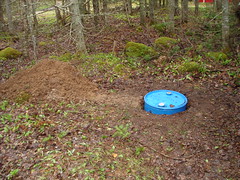

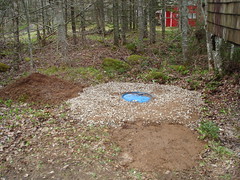

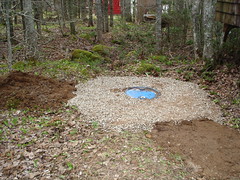
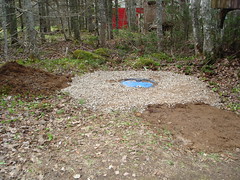
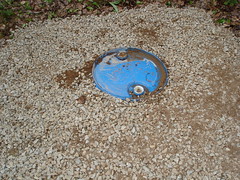

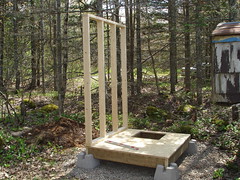
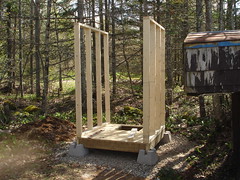
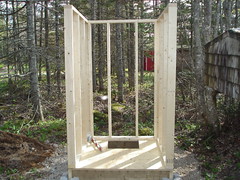
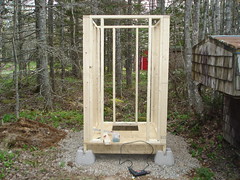
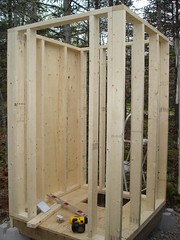
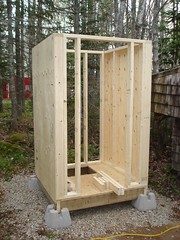
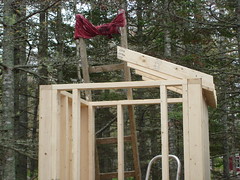
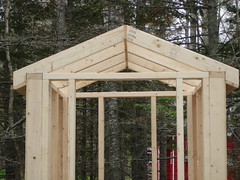

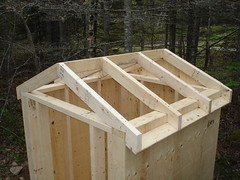

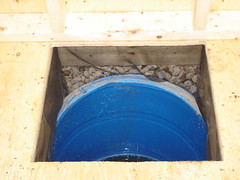
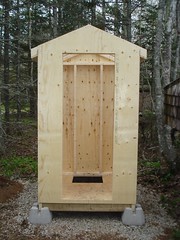

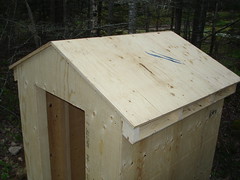
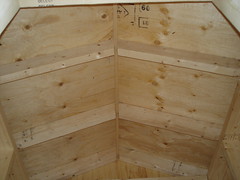
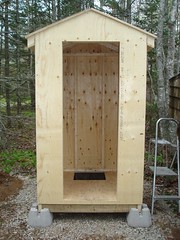
Do you know if there is plans for this outhouse, if so where could I get them.
ReplyDeleteThanks Mel Johnson
Do you know if there is plans for this outhouse, if so where could I get them.
ReplyDeleteThanks Mel Johnson